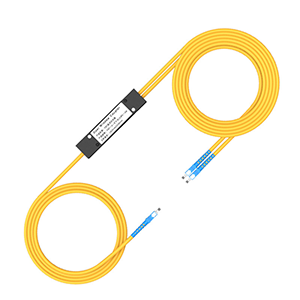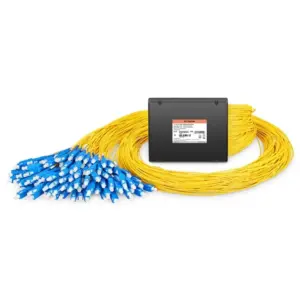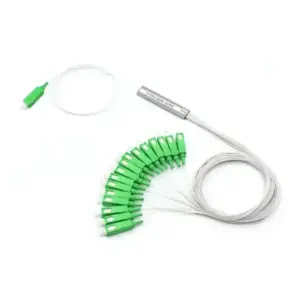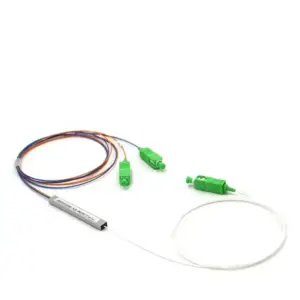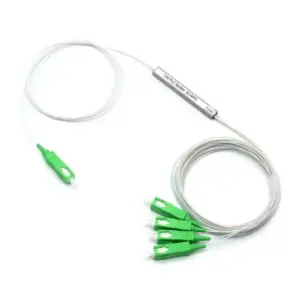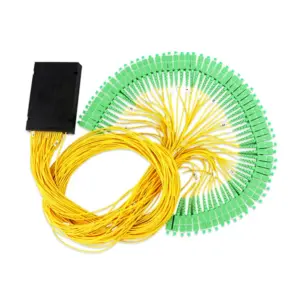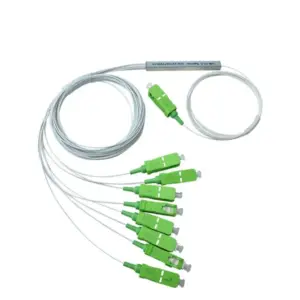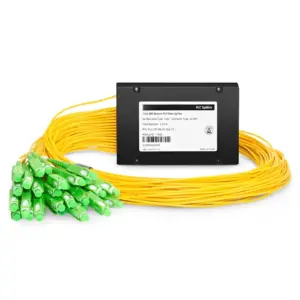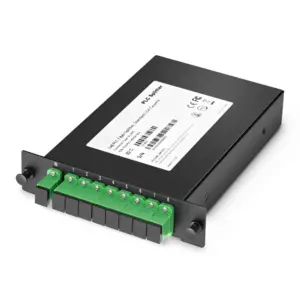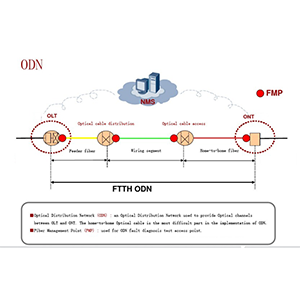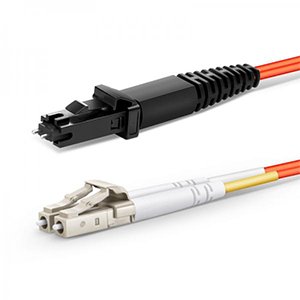Hello everyone! Today I want to share with you a piece of equipment that plays an important role in fiber optic networks – fiber optic splitters. As a key component in fiber optic communications, fiber optic splitters play an important role in achieving efficient data transmission and signal distribution. In this article, I will take you in-depth understanding of the principles, types and application fields of fiber optic splitters, so that you can better understand its importance and advantages.
Basic principles of optical spliter
A fiber optic splitter is an optical device used to distribute input optical signals to multiple output ports. It is based on the principle of light interference to realize the splitting of optical signals. The following is the basic principle and working method of fiber optic splitter:
How it works:
Fiber optic splitters typically use grating or waveguide technology. Among them, the most common ones are grating beam splitters and coupler beam splitters.
Grating beam splitter: The grating beam splitter uses the grating structure to distribute the input optical signal to different output channels through the principles of interference and diffraction. The periodic refractive index changes in the grating will cause light of different wavelengths to be deflected differently during diffraction, thereby achieving a light splitting effect.
Coupler splitters: Coupler splitters take advantage of the propagation properties of light in fiber optic waveguides. The input optical signal enters the optical waveguide through the port of the coupler, and the optical signal is distributed to different output ports through the transmission and coupling process of the optical waveguide. The working principle of a coupler beam splitter involves the coupling, transmission and distribution of light.
Spectral function:
The main function of the optical fiber splitter is to distribute the input optical signal to multiple output ports according to different wavelengths or frequencies. In this way, one input light source can provide multiple output signals at the same time, thereby realizing the distribution and multiplexing of optical signals. Optical fiber splitters are often used in fields such as optical fiber communication systems, optical sensor networks, and optical fiber transmission systems to achieve the distribution, analysis, and monitoring of optical signals.
Influencing factors and importance:
Fiber optic splitters play an important role in the network, and their performance and influencing factors include:
- Split Ratio: Indicates the relative intensity of the input optical signal distributed to each output port. The choice of splitting ratio is related to specific application requirements and system design.
- Insertion Loss: Signal loss introduced by the optical splitter. Lower insertion loss helps maintain signal quality and transmission efficiency.
- Coupling Uniformity: The optical signal coupling consistency between different output ports of the optical splitter. Higher coupling uniformity ensures that the signal strength of each output port is relatively balanced.
- Operating Wavelength Range: Indicates the wavelength range of optical signals that the optical splitter can process. The wavelength range is appropriately selected to meet the needs of the specific application.
The correct selection and use of fiber optic splitters is critical to network performance and signal distribution stability. Reasonable consideration of factors such as splitting ratio, insertion loss, coupling uniformity and operating wavelength range can ensure that the optical fiber splitter plays an effective role in the network and achieves high-quality optical signal distribution and transmission.
What are the common optical spliter types
Common types of fiber optic splitters include average power splitters and proportional splitters. They have different working principles and application scenarios. Here’s a detailed introduction to each type:
Average power splitter:
- Working principle: The average power optical splitter evenly distributes the input optical signal to multiple output ports, so that each output port receives equal optical power. It is implemented through grating or waveguide technology, ensuring that each output channel has the same transmission loss.
- Application scenarios: Average power splitters are often used in applications that require even distribution of optical signals to multiple receivers, such as fiber optic sensing, fiber optic temperature measurement, fiber optic spectrum analysis, etc. In these applications, average power splitters ensure that each receiver receives uniform optical power to improve measurement accuracy and system performance.
Proportional beam splitter:
- Working principle: The proportional optical splitter distributes the input optical signal to multiple output ports according to a predetermined splitting ratio, so that each output port receives different optical power. It is implemented through grating or waveguide technology to control the distribution ratio of optical signals between different channels according to design requirements.
- Application scenarios: Proportional optical splitters are often used in applications that require the distribution of optical signals according to a specific ratio, such as optical splitting and multiplexing in optical fiber communication systems, optical fiber transmission and optical networks. It can distribute optical signals to different channels to meet the needs of different receivers or systems.
Insertion loss and uniformity performance are very important when selecting and using fiber optic splitters:
Insertion loss: Insertion loss refers to the signal loss introduced by the fiber optic splitter. Lower insertion loss means less signal attenuation and higher transmission efficiency. In applications, attention needs to be paid to selecting an optical splitter with lower insertion loss to ensure the quality and intensity of the optical signal.
Uniformity: Uniformity refers to the consistency of optical signal distribution between different output ports of the optical splitter. Higher uniformity can ensure that each output channel receives relatively balanced optical power and avoid signal distortion and uneven optical signal distribution. In applications that require precise optical power control and balancing, it is important to select a beam splitter with high uniformity.
Therefore, when selecting a fiber splitter, it is necessary to comprehensively consider the insertion loss and uniformity performance, and make an appropriate selection based on the needs of the specific application scenario.
Overview of the application fields of optical splitter
Fiber optic splitters are widely used in many fields. The following are some typical application cases:
Optical communication:
- Fiber optic transmission system: Fiber optic splitters are used to distribute optical signals to different transmission channels to achieve multiplexing and distribution of optical signals. They play a key role in fiber optic networks, providing efficient signal distribution and flexible network topology.
- Fiber optic sensing: The fiber optic sensing network uses fiber optic splitters to distribute optical signals to multiple sensor nodes to achieve real-time monitoring and measurement of physical quantities such as temperature, strain, and pressure. Fiber optic splitters ensure that optical signals are evenly transmitted to various sensor nodes to improve the accuracy and reliability of the sensor network.
Wireless network:
- Optical wireless communication system: Optical fiber splitters are used in optical wireless communication systems to distribute optical signals to different wireless transmitting antennas to achieve multi-user optical wireless access. They provide high-bandwidth and low-latency wireless communication solutions and support large-scale user access.
- Fiber optic distributed antenna system: Fiber optic splitters are used to distribute optical signals to different distributed antenna units to achieve wireless coverage in indoor and outdoor environments. Fiber optic splitters ensure that optical signals are transmitted evenly to individual antenna units to provide balanced wireless signal coverage and capacity enhancement.
Sensor Network:
- Fiber optic spectral sensing: Fiber optic spectrometers are used in spectral sensing applications to distribute optical signals to different spectral analysis instruments or sensors to achieve spectral analysis and monitoring of material composition, chemical reactions, etc.
- Fiber optic temperature sensing: Fiber optic splitters are used to distribute optical signals to multiple temperature sensors to achieve high-precision measurement and monitoring of the temperature field. They are widely used in fields such as industrial control, environmental monitoring and energy systems.
Fiber optic splitters play a key role in these application areas, enabling signal distribution, analysis and monitoring. They can provide highly reliable signal distribution and transmission and support the expansion and flexibility of large-scale networks, thereby promoting the development and application of optical communications, wireless networks, sensor networks and other fields.
Overview of optical spliter installation and maintenance matters
The installation and maintenance of fiber optic splitters require attention to the following key steps and precautions:
Installation steps:
- Environment selection: Choose an installation environment suitable for the fiber optic splitter to avoid the impact of excessive temperature, humidity, dust, etc. on the equipment.
- Fiber optic connection: Correctly connect the input and output optical fibers, and ensure the quality of the optical fibers and the matching of the interfaces.
- Power connection: Connect the appropriate power source and ensure that the power supply voltage meets the device requirements.
- Fixed installation: Fix the fiber optic splitter in a suitable position to prevent the equipment from loosening or being disturbed by external vibrations.
Protective measures:
- Dust protection: Use a suitable cover or dust cover to protect the interface of the fiber optic splitter to prevent dust and impurities from entering the equipment and affecting performance.
- Moisture-proof protection: Avoid exposing the optical fiber splitter to moisture and use moisture-proof materials to protect the equipment from moisture corrosion.
- Prevent physical damage: Protect the fiber optic splitter from damage such as physical impact, squeezing or bending, and avoid unnecessary pressure or force on the equipment.
Maintenance precautions:
- Regular cleaning: Regularly clean the interface and fiber end face of the optical fiber splitter, and use appropriate cleaning tools and methods to avoid dust and dirt from interfering with signal transmission.
- System monitoring: Regularly monitor the working status of the optical fiber splitter, including power loss, uniformity and signal quality, and handle any abnormalities in a timely manner.
- Pay attention to optical power: Avoid inputting too high optical power into the fiber splitter to prevent equipment damage or performance degradation.
FAQs and troubleshooting:
- Increased insertion loss: It may be caused by poor fiber connection, fiber end face contamination, or internal failure of the fiber splitter. Solutions include cleaning and reconnecting the fiber, or replacing the failed fiber splitter.
- Non-uniformity problem: It may be caused by inaccurate light splitting ratio inside the fiber optic splitter or poor fiber connection quality. Solutions include adjusting the beam splitter settings or replacing the bad connection components.
- Fiber breakage or damage: It may be caused by physical pressure, bending or tension. Solutions include repairing or replacing damaged fiber and ensuring proper installation and protection of the fiber.
Proper handling and protection of fiber optic splitters is key to ensuring their proper operation and long life. The performance and reliability of your fiber optic splitter can be ensured by following proper installation and maintenance procedures, regularly inspecting and cleaning equipment, and promptly handling any abnormalities.
Summary
As the core equipment of optical fiber networks, fiber optic splitters exhibit outstanding performance in various fields with their high performance and low insertion loss. Whether you are in optical communications, wireless networks or sensor networks, fiber optic splitters can achieve signal distribution and transmission, helping you achieve high-speed and reliable data transmission.
We provide various types of fiber optic splitters, such as average power splitters, proportional splitters, and PLC splitters, to meet different needs and application scenarios. If you have more questions about fiber optic splitters or need more details, please feel free to contact us.
optical spliter FAQ
Optical splitters work based on various techniques such as fused biconical taper (FBT) or planar lightwave circuit (PLC). They divide an incoming optical signal into multiple output signals or combine multiple input signals into a single output.
Optical splitters are commonly used in various applications, including passive optical networks (PONs), fiber-to-the-home (FTTH) installations, cable television (CATV) networks, telecommunications systems, and fiber optic test and measurement setups.
The common types of optical splitters are: 1×2, 1×4, 1×8, 1×16, 1×32, and 1×64, where the first number represents the number of input ports and the second number represents the number of output ports. There are also splitters with different splitting ratios, such as 50:50 or 80:20.
Yes, optical splitters can be designed to work with both single-mode and multimode fibers. It is important to select the appropriate type of splitter that matches the fiber type being used.
Yes, optical splitters introduce some level of signal loss due to the splitting process. The amount of loss depends on factors such as the splitting ratio, the quality of the splitter, and the operating wavelength.
Yes, optical splitters can be cascaded or connected in series to achieve further splitting or combining of signals. This allows for more output ports and greater distribution of optical signals.
Optical splitters can be designed for both unidirectional and bidirectional transmission. Bidirectional splitters combine signals from multiple inputs into a single output or split a signal from a single input into multiple outputs, allowing signals to be transmitted in both directions.
Yes, optical splitters can be used in conjunction with wavelength division multiplexing (WDM) systems to combine or separate optical signals of different wavelengths. This enables the transmission of multiple signals over a single fiber.
Yes, optical splitters are passive devices, which means they do not require any external power source or active components for their operation. They rely on the characteristics of the fiber and the splitter technology to split or combine signals.
optical spliter FAQ
-
128-channel optical fiber PLC splitter
-
16-channel optical fiber PLC splitter
-
2-way optical fiber PLC splitter
-
32-channel optical fiber PLC splitter
-
4-way optical fiber PLC splitter
-
64-channel optical fiber PLC splitter
-
8-channel optical fiber PLC splitter
-
ABS module PLC fiber optic splitter
-
Box PLC optical fiber splitter

